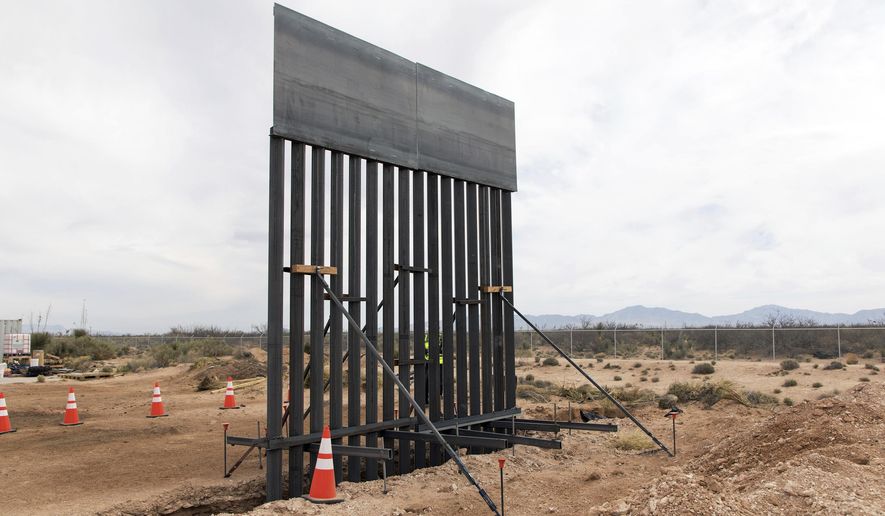The $5 billion President Trump demanded for border wall construction would build 215 miles of new or replacement barrier along the U.S.-Mexico border, averaging a staggering $23.3 million per mile.
That is five times more expensive than fencing averaged during the Bush and Obama years — although the Department of Homeland Security says it’s impossible to compare because each project is in a different location, with different requirements.
The 215 miles the Trump administration says it could build would be split among four sectors of the border. The Rio Grande Valley area of Texas would be the top priority, followed by eastern California and western Arizona, and then Laredo, Texas.
“We know where we would go next, and this is based on field commanders’ input,” a Homeland Security official said last week while briefing reporters on the administration’s request.
But only about 100 of the 215 miles would be new locations.
The rest would be a replacement for outdated barriers in some areas or added layers to back up the border fence.
The White House this weekend signaled a willingness to cut its dollar target below $5 billion, saying the final amount should be somewhere between that and the $1.3 billion included in last year’s Homeland Security funding bill. That lower figure is the maximum Democrats say they will accept.
Part of the fight is also about semantics.
Mr. Trump has repeatedly said that he is building a wall, but what has been constructed over the past couple of years is an improved version of the same border fence that has been standard for a decade.
Agents call it bollard fencing because it uses poles 18 feet or taller lined side by side with small gaps in between. Those gaps are crucial for visibility into Mexico, agents say, giving them the chance to spot ambushes.
Mr. Trump last week called it “steel slats,” and his budget director on Sunday called it fencing rather than a wall — a major concession for a president who has pointedly corrected people who called his barrier a fence.
“It’s not a fence; it’s a wall,” the president said during a press conference just before his inauguration last year.
At that time, he also announced that he was not going to wait for his pledge to make Mexico fund the wall.
Making taxpayers fund the project has been a major focus of Democrats, who ridicule the president for taking back that part of his pledge. He retorts that better trade terms will enrich the U.S. enough to cover the costs — though the numbers on that claim are uncertain at best.
Agreeing to spend new money only on bollard-style fencing is a significant concession for the White House because it rules out any of the concrete designs that Mr. Trump forced the Border Patrol to test last year.
Thus, the fence being built is essentially the same as the hundreds of miles that dozens of Democrats voted for in 2006.
That could undercut Democrats’ debate over semantics, claiming they support fencing but not a wall.
“I have never supported a border wall, and I challenge anyone on the hard right to find a time when I, or any expert, has supported a wall like what the president has proposed,” Senate Minority Leader Charles E. Schumer, New York Democrat, said on the chamber floor Saturday.
The president’s $5 billion demand is just a down payment on Mr. Trump’s borderwide vision. All told, the administration says, he wants 700 miles of wall at a total cost of $18 billion.
But a number of those details remain shrouded — including exact locations of fencing.
Officials say they have given Congress a full blueprint but have refused to make it public.
The cost of that 700-mile plan, averaging $25.7 million per mile, is also an issue.
Homeland Security officials also bristled at those calculations.
The department said it’s not fair to compare that price tag to the $4 million to $6 million per mile of fence spent on projects during the Obama administration. Officials said what is being built now is a “system,” which includes the barrier as well as a roadway to allow Border Patrol agents easy access.
“If you’ve built 1 mile of border wall, you’ve built 1 mile of border wall,” an official said.
The places where the wall has worked best involve at least two or sometimes three tiers of fencing, with one tier up against the border, then a high-speed road, then the next tier or two. That way, immigrants who manage to climb over the first fence will have to surmount the second one, while on U.S. soil, and with agents patrolling the road.
That is the kind of fencing built in the Clinton and Bush years in San Diego and in Yuma, Arizona. In each of those places, the multitier fencing helped cut illegal immigrant arrests by more than 90 percent.
• Stephen Dinan can be reached at sdinan@washingtontimes.com.
• S.A. Miller can be reached at smiller@washingtontimes.com.




Please read our comment policy before commenting.